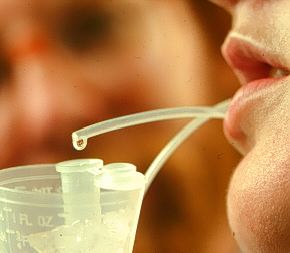What is Sjögren's Syndrome?
Sjögren’s syndrome, named after the Swedish ophthalmologist, Henrik Sjögren, is an autoimmune disorder. An autoimmune disorder is one in which the immune system attacks a person’s own body. This attack gives rise to inflammation that may cause destruction of the tissues of the body or impair their function. In Sjögren’s syndrome salivary and tear glands are the major targets of the attack and the result is a decrease in production of saliva and tears. The lack of saliva may cause symptoms of dry mouth (known as xerostomia), difficulties with speech and swallowing food, extensive tooth decay, tooth loss, oral sores and fungal infections in the mouth. The salivary glands may enlarge to produce visible swelling, particularly below the ears at the angle of the jaw, and this may be confused with mumps. Inadequate production of tears can produce symptoms of irritation and a feeling of having grit or sand in the eyes. Many Sjögren’s syndrome sufferers experience debilitating fatigue. Blood tests show the presence of autoantibodies. Antibodies are substances produced by the immune system of the body to defend against foreign material, including viruses and bacteria. However, in Sjögren’s syndrome, these antibodies are directed against components of the body, such as cells or large molecules.
Who gets the disorder?
Sjögren’s syndrome is thought to affect more than one million people in the United States alone. The disorder can occur at any age, but the average person with the disorder at our clinic is in his or her late fifties. Women with the disorder outnumber men by 9:1. Sjögren’s syndrome may occur alone or in association with other diseases such as rheumatoid arthritis or lupus.
Where is the Clinic?
We are located in the Molecular Physiology and Therapeutics Branch (MPTB), National Institute of Dental and Craniofacial Research (NIDCR), National Institutes of Health (NIH) at the Warren Grant Magnusson Clinical Center in Bethesda, Maryland. Here we conduct basic and clinical research on salivary function and Sjögren’s syndrome.
The Sjögren’s Syndrome Clinic: Past and Present
 Drs. Bruce Baum and Phil Fox established the first dry mouth clinic in the United States in 1982. They made a conscious decision to operate out of a bench-to-bedside program. The effort has progressed from fundamental bench studies of salivary physiology to immunological investigations and most recently toward gene therapy and the development of artificial salivary glands. In each of these areas the studies included research that has progressed from cellular studies to animal model studies and finally toward clinical studies. Sjögren’s syndrome studies are conducted in the Molecular Physiology and Therapeutics Branch, NIDCR that is headed by Dr. Indu Ambudkar. Excluding patients who visited the clinic purely to arrange for and have laboratory and other tests, more than 300 patient visits occurred at the Salivary Dysfunction Clinic in the past year. Currently more than 100 Sjögren’s syndrome patients are regularly followed at the clinic each year. We have collected systematic clinical and laboratory data on the Sjögren’s syndrome (and salivary dysfunction) population for a number of years. Over 1200 patients with salivary dysfunction have been evaluated since the inception of our clinic. Dr. Fox left the National Institutes of Health in December 1998, and Dr. Gabor Illei, a rheumatologist who has wide experience in the area of clinical trials, currently oversees the Sjögren’s Syndrome Clinic.
Drs. Bruce Baum and Phil Fox established the first dry mouth clinic in the United States in 1982. They made a conscious decision to operate out of a bench-to-bedside program. The effort has progressed from fundamental bench studies of salivary physiology to immunological investigations and most recently toward gene therapy and the development of artificial salivary glands. In each of these areas the studies included research that has progressed from cellular studies to animal model studies and finally toward clinical studies. Sjögren’s syndrome studies are conducted in the Molecular Physiology and Therapeutics Branch, NIDCR that is headed by Dr. Indu Ambudkar. Excluding patients who visited the clinic purely to arrange for and have laboratory and other tests, more than 300 patient visits occurred at the Salivary Dysfunction Clinic in the past year. Currently more than 100 Sjögren’s syndrome patients are regularly followed at the clinic each year. We have collected systematic clinical and laboratory data on the Sjögren’s syndrome (and salivary dysfunction) population for a number of years. Over 1200 patients with salivary dysfunction have been evaluated since the inception of our clinic. Dr. Fox left the National Institutes of Health in December 1998, and Dr. Gabor Illei, a rheumatologist who has wide experience in the area of clinical trials, currently oversees the Sjögren’s Syndrome Clinic.
Gene therapy has the potential for inserting molecules such as cytokines that could modulate inflammation in salivary glands to slow or prevent their destruction in Sjögren’s syndrome. Also, the capacity to produce molecules that enhance saliva production by residual salivary gland cells, might be introduced by gene transfer. Eventually, development of artificial salivary glands may have application in patients, who have lost all functional salivary glands, because of radiation treatment or Sjögren’s syndrome. We are expanding our recruitment of patients so that we can accelerate the conduct of clinical trials for the disorder.